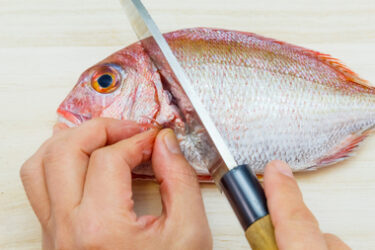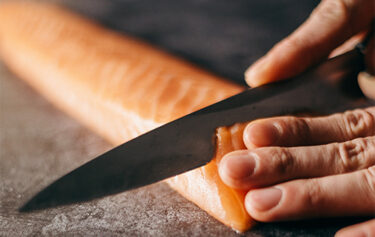Santoku knives are very popular kitchen knives for use around the home, because it’s easy to use for meat, fish, and vegetables.
However, there are many types of materials, blade sizes, brands, etc., and many people may not know which one to choose.
In this article, we will introduce basic information about Santoku kitchen knives, how to choose the best one, and how to sharpen Santoku kitchen knives.
Uses and Features of Santoku Knives
Santoku Knives are named after three(San in Japanese) benefits(Toku in Japanese) that are suitable for meat, fish, and vegetables.
After 1900, Western cooking became more common in Japan, and Gyuto knives were introduced from overseas. Santoku knives were born from the combination of the Gyuto and Nakiri Knives(Japanese knife for cutting vegetables).
Most of Santoku knives have a blade length of 16~18cm. The wide blade is suitable for cutting vegetables, and the double-edged blade makes it easy to cut vegetables vertically and straight.
The edge of the blade is gradually curved and sharp, making it easy to cut sashimi and trim meat.
It’s often thought of as a single-edged knife which is a basic feature of Japanese knives, but it’s a double-edged knife.
There are a few single-edged santoku knives available. These knives have a higher sharpness than double-edged knives, but the price is slightly higher.
FAQ
Gyuto vs Santoku Knives
Santoku knives have a shorter blade than gyuto knives and are lighter and easier to work with.
How to Choose the Best Santoku knife
“How should I choose a Santoku knife?”
Here are some tips on how to choose a Santoku knife.
What ingredients do you usually cut?
Santoku knives are easy to use for all kinds of food, but the best shape depends on what kind of food you tend to cook.
First of all, the length of the blade is generally 16~18cm, but if you are cutting large pieces of meat or fish, a longer knife is more suitable. On the other hand, if the blade is small, it is easier to work with and lighter to handle.
The thicker the blade, the easier it is to cut vegetables, and the thinner and sharper the edge, the better it is for cutting meat and sashimi.
Select the Blade Material
The material of the blade is also an important factor in choosing a santoku knife. If you want to focus on sharpness, choose a santoku knife made of steel. The sharpness of the blade is much higher than that of other materials, and you can cut easily. However, they are prone to rusting and need to be cleaned frequently. If you are looking for a knife that is easy to clean, I recommend a stainless steel santoku knife. Stainless steel knives are slightly less sharp than steel knives, but they are rust-resistant and easy to sharpen, making them suitable for beginners and those who do not want to spend too much time on maintenance.
There are also many other knives made of titanium and ceramic.
The characteristic of titanium is its lightness. It is so resistant to rust that it almost never rusts even when placed in salt water, and it also sterilizes itself when exposed to sunlight or fluorescent light, making it excellent for cleanliness.
Ceramic is lightweight and non-metallic, so it will not rust. It is suitable for slicing because it can maintain a certain strength even though it is thin, but it is not suitable for cutting hard food because it chips easily.
Select a Handle
The handle is also important in choosing a santoku knife.
There are two types of handles, one integrated with the blade and the other separated, mainly made of stainless steel.
The advantage of the integrated type is that it does not accumulate dirt and is easy to clean. The separate type may accumulate dirt or lose its stability after a long period of use, but it looks luxurious.
Need to Select According to Your Dominant Hand?
“No it’s not!”
Santoku knives are generally double-edged, so unlike single-edged knives such as willow-blade knives, both right-handed and left-handed people can use the same knife.
But some Santoku knives are single-edged, so be sure to pay attention to your handedness when using a single-edged Santoku knife.
What is the Best Way to Care for a Santoku Knife?
Santoku Knives are often used for home use and are mainly made of rust-resistant stainless steel, so there is no problem in daily maintenance as long as you clean them with detergent after use, wipe off the water, and dry them thoroughly.
However, the sharpness of the blade will degrade if you continue to use it for a long period of time, so it is best to sharpen it every six months or so to maintain a high level of sharpness.
Let’s try sharpening with the help of the video and English instructions.
1.Prepare a whetstone: For general households, synthetic whetstones, which are a mixture of two main materials, are recommended because they are affordable and can be used on both steel and stainless steel. It is recommended to choose a medium grit.
2.Preparation before sharpening: Soak the grinding stone in water for about 20 minutes. Lay out a wet cloth to prevent the wheel from slipping, and place the wheel on the cloth.
3.sharpenning: Place the knife at an angle of about 45 degrees to the grindstone with the blade facing you. Put the blade on the grindstone and sharpen the front side of the knife by sliding the blade back and forth on the grindstone with the edge of the knife (opposite the blade) slightly raised. When sharpening the back side of the knife, sharpen it in the opposite way to the front side so that the blade faces outward, putting more force when pulling and less when pushing. Finally, rub both sides of the knife against a piece of newspaper to remove any metal blisters or shavings called “kaeri”.
Summary
Santoku knives are mainly used for home use, and if you have one, it is a convenient knife that can be used for meat, fish, vegetables, and everything else.
Many knives are made of stainless steel and are easy to handle. They can be used without sharpening, but occasional sharpening will keep them sharp.
You can use them without sharpening, but occasional sharpening will keep the sharpness high.
Why don’t you find one of your favorite Santoku knives that will make your everyday cooking more enjoyable and delicious?



